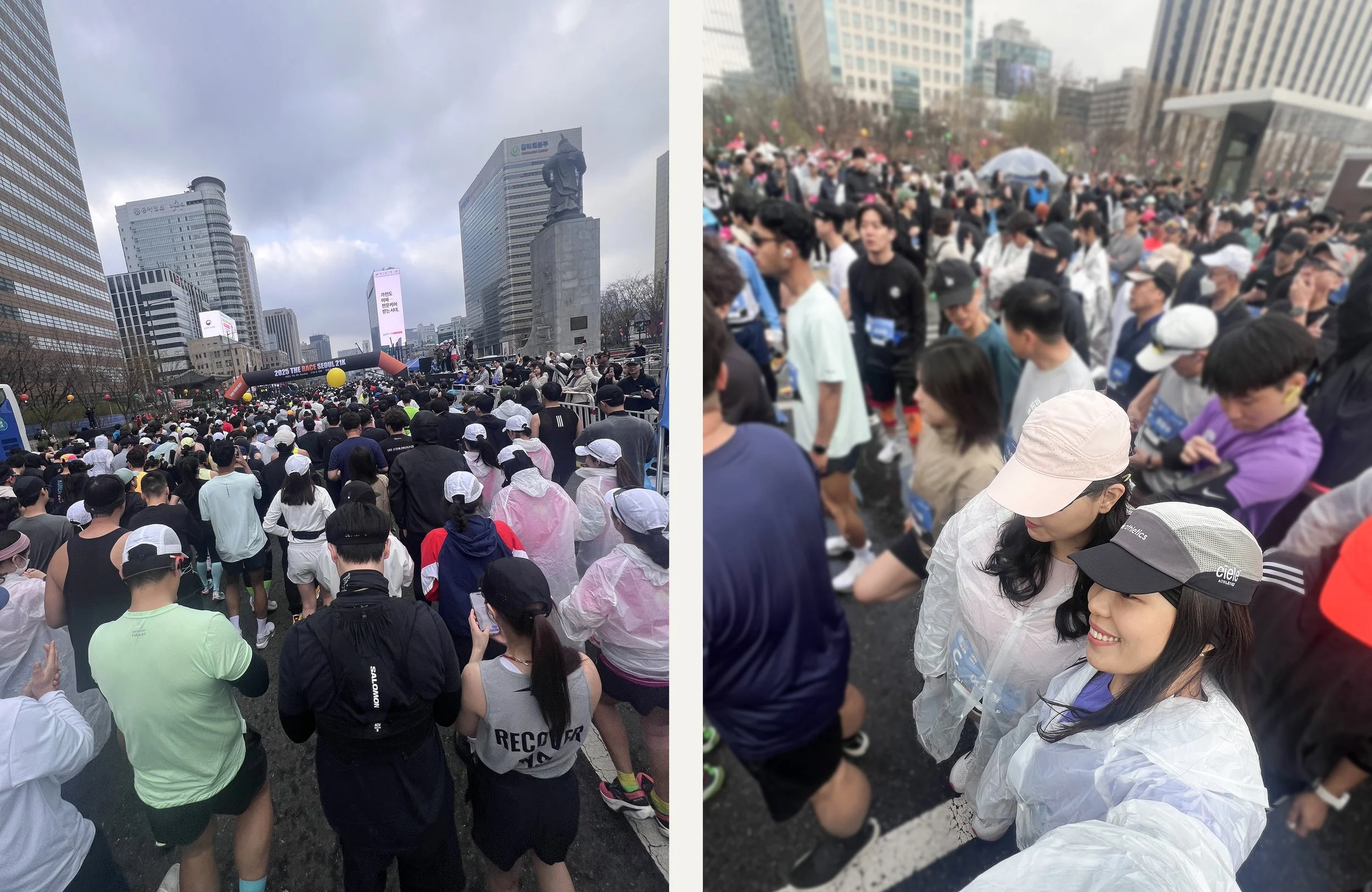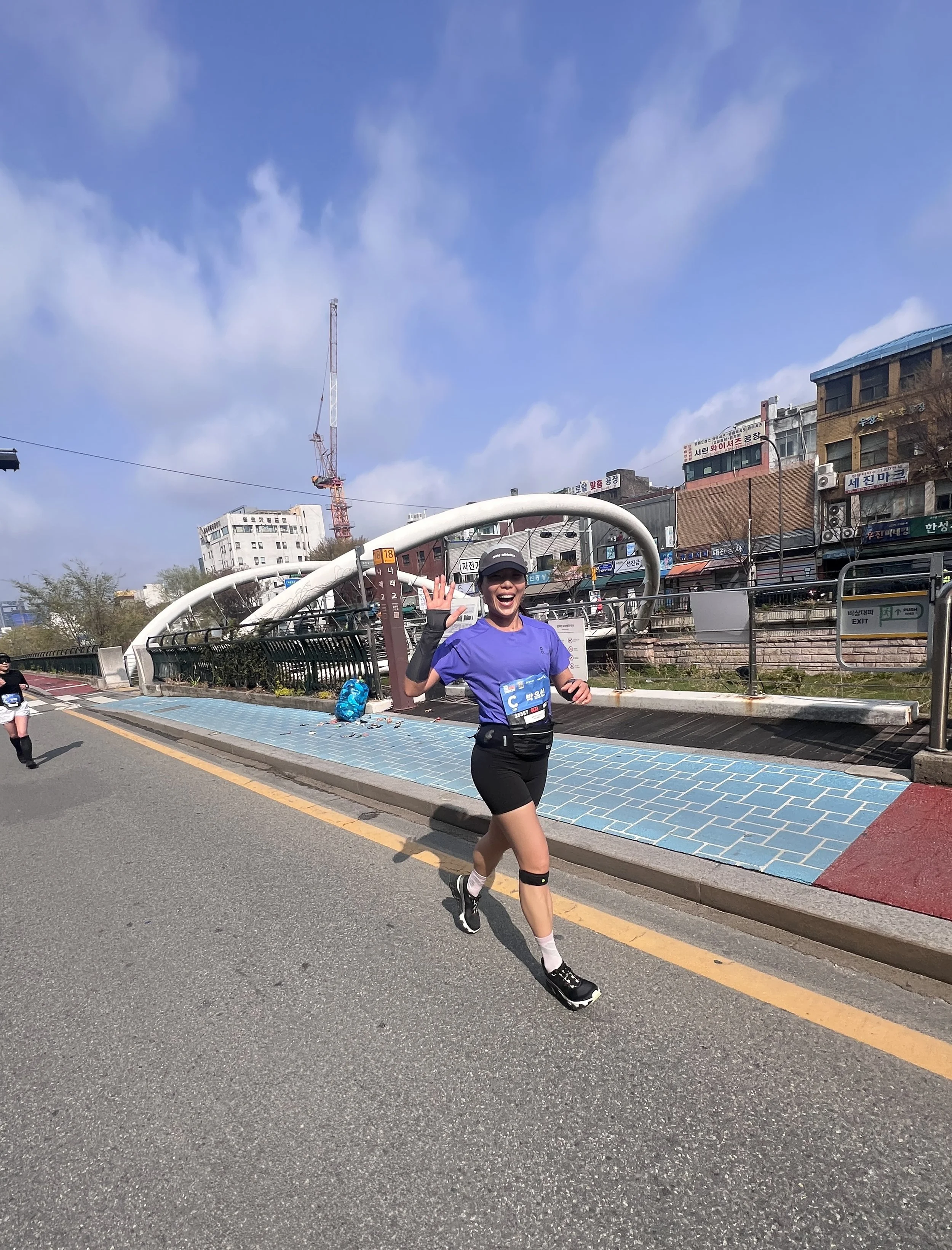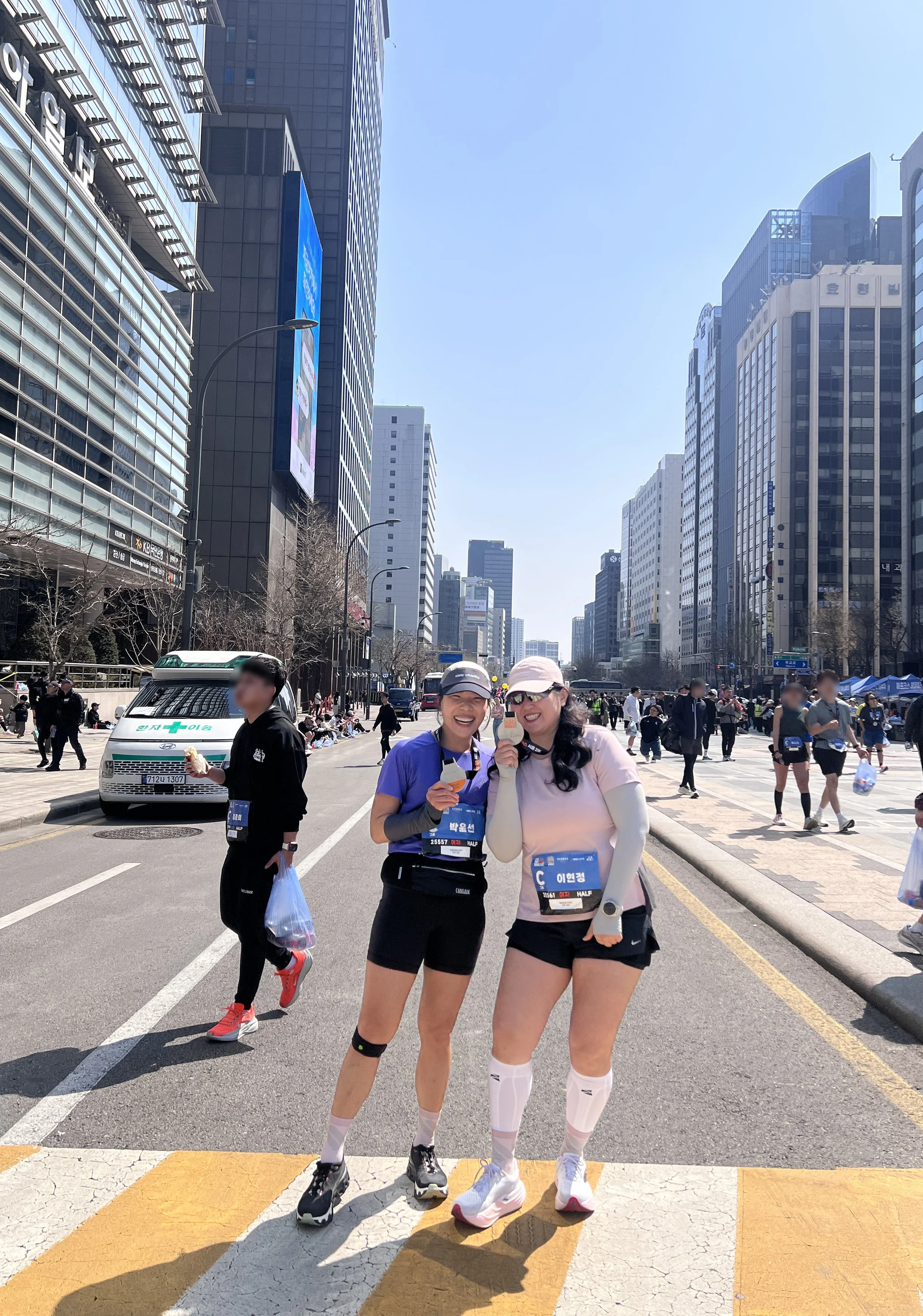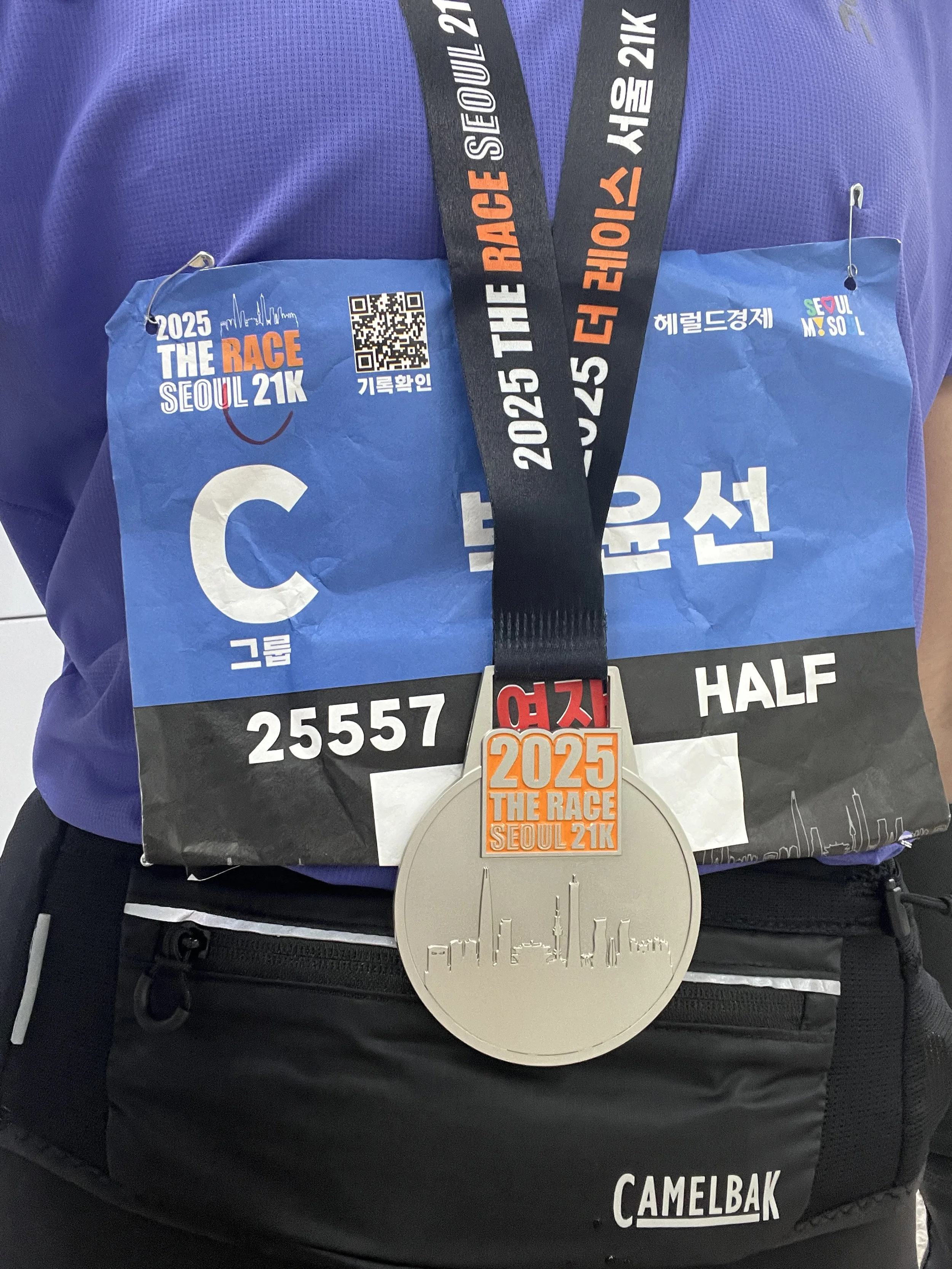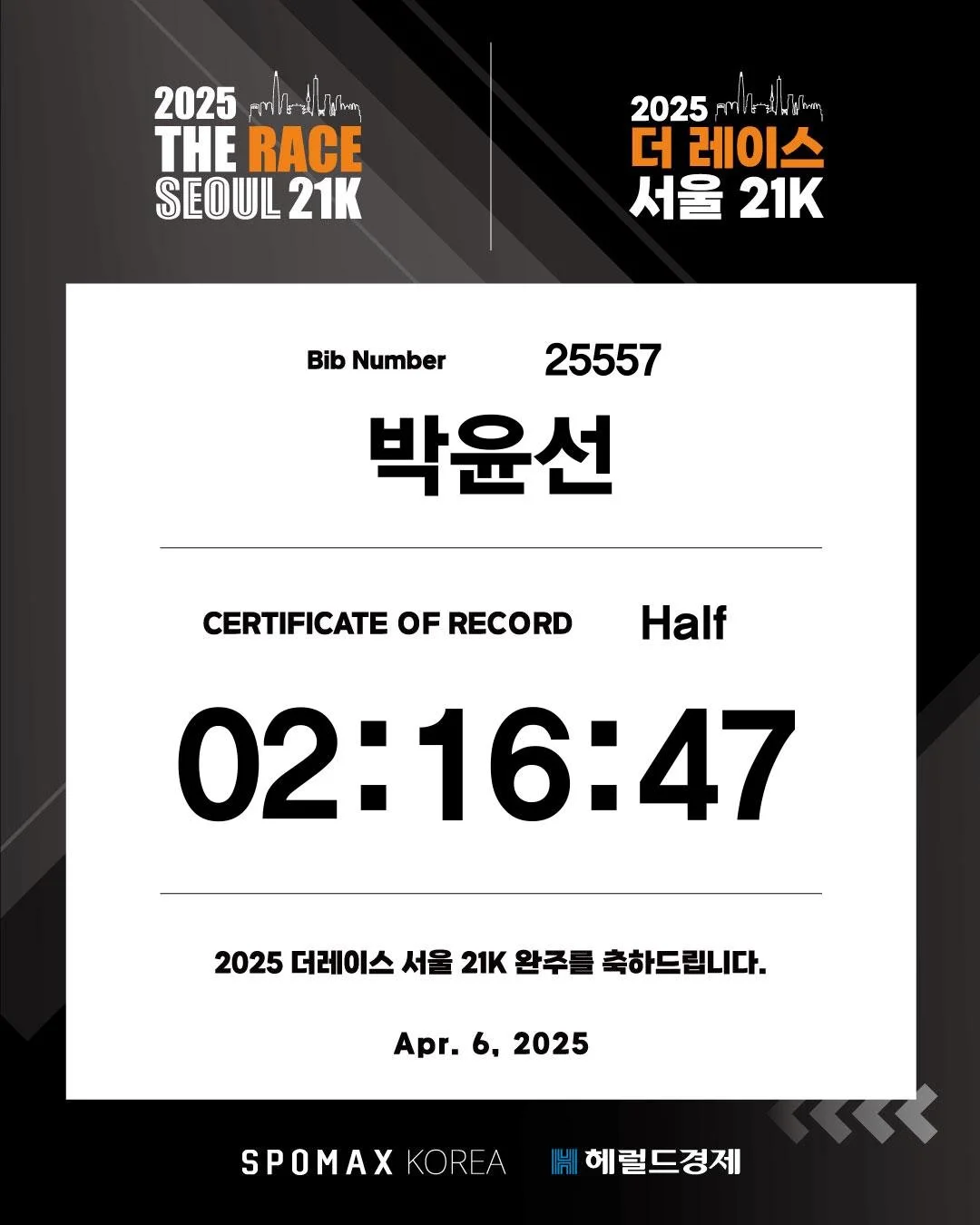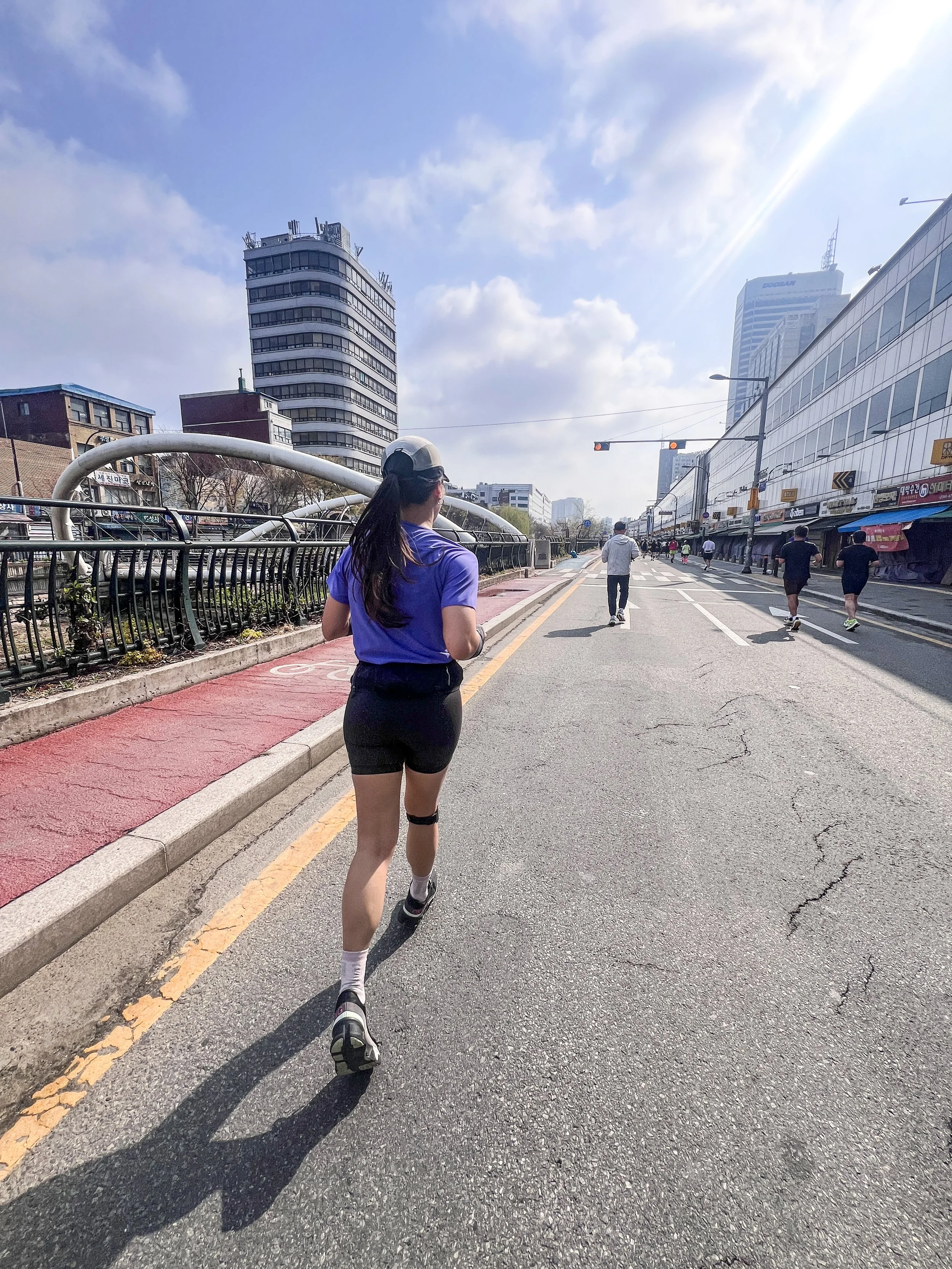My First Half-Marathon! – The Race Seoul 21K
( Apr.06.2025 )
April 4th, 2024 is the date that has become something like an anniversary for me. It was the day I first decided to start running, to try running 5K every morning. One year later, almost to the day, on April 6th, I found myself standing at the start line of my very first half marathon.
Between Doubt and Dream: The First Step to 21K
At first, it was just about running those daily 5Ks. But as the days stacked up, I reached a point where I could run 10K. I even joined a 10K race. As I found joy in running and kept at it, a new sense of purpose quietly grew in me, a curiosity about going farther. One day, I ran beyond my longest distance so far, 10K, and tried 15K for the first time. To my surprise, I felt like I could probably go a little farther. The following week, I set my sights on 22K. I told myself, “Let’s just see how far I can go today.” And somehow, I kept going until I reached 22K. That became my very first unofficial half marathon.
Somewhere along the way, I came across a phrase saying, “10K is just a running race, but if you want to say you’re running a marathon, it starts from the half marathon.” I couldn't agree more. That simple idea stuck with me, and planted a seed of a dream. Could I really run a half marathon? I wasn’t sure. Maybe 33% doubt, 33% confidence, and 34% hope.
Then one day, I saw an announcement for a half marathon taking place in Seoul. Registration was opening soon.
Since the summer of 2024, running has exploded in popularity in Korea. Demand for races far outpaced supply. To register for any major race in Seoul, you had to be ready the moment registration opened, clicking as fast as you could. Even then, the servers often crashed from the flood of people trying to sign up. You needed a bit of luck to break through that chaos and actually secure a spot. Succeeding in registration felt like winning the lottery.
The race I signed up for, The Race Seoul 21K, was no different. Even though it was the very first edition, it was set to take place in Gwanghwamun, right in the heart of the city, so I knew it would draw a big crowd. I marked the registration date on my calendar and set an alarm for ten minutes before. When the alarm rang, I logged in to the website and waited for the registration to open. Half of me was eager, hoping I could get in. The other half? Terrified. What if I did get in? Then I’d really have to run a half marathon!
And as if answering that fear, the process went too smoothly. No crashes, no errors. Just like that, I was signed up in minutes. I sat there staring at the confirmation screen, half in disbelief.
Is this really happening? Am I really running a half marathon?
Waiting for Spring, Waiting for Myself
This race was originally scheduled for February 23rd. But unexpected political protests surrounding the impeachment of Korea’s president began to unfold, with gatherings centered around Gwanghwamun, the very place where the race was set to take place. For safety reasons, the race date was postponed to April 6th. I remember feeling relieved. Looking back, I don’t think I was ready, physically and mentally, to run a half marathon in February.
The beginning of my 2025 was severe. January and February felt heavier than I could carry. I was emotionally drained, as though all the effort I had put into my life until then was being dismissed. I slipped into a state where everything felt too heavy to face, an exhaustion that drained both body and spirit, leaving me feeling disconnected from everything I cared about. For those two months, I could barely manage what was absolutely necessary. Beyond that, I couldn’t bring myself to do much else. As race day on February 23rd crept closer, the thought crossed my mind more than once – maybe I should cancel, maybe I just shouldn’t go. Each time, I tried to reassure myself. Just show up. Run what you can. Even if I can’t run the whole thing, that’s still worth more than giving up before even trying. I held onto that thought, waiting for time to pass, waiting for this too to pass.
And then I received the news that the race had been postponed. It felt like life had handed me a quiet gift, a much-needed second chance.
Even then, it wasn’t easy to find my footing again. A winter that was too still, almost hollow and piercing, had to pass before I could begin to feel ready. It wasn’t until March 10th, after the stillness of that season had faded, that I finally laced up my running shoes again and stepped out into the sunlight, knowing I couldn’t put it off any longer. It had been nearly seventy days since my last run.
I took my time, warming up carefully, gently waking my muscles before I began to move. When I had been running regularly, my legs often felt heavy from accumulated fatigue. But now, my body felt light, as if my muscles had woken fresh from a long winter’s sleep. Still, it didn’t take long to feel how much stamina I had lost. I slowed my pace even more. Don’t push, don’t expect too much. Just loosen up, like the first time you ever ran. I reminded myself of that and ran slowly for an hour, easing my body back into movement, letting go of the stillness that had caged me through the winter.
The hardest part of running is always just getting out the door, tying my shoes and taking that first step outside. When I finally worked up the courage to head out again, spring greeted me with open arms. As I started to move, I could feel the warmth of the sunlight and the breeze against my skin. Although I wasn’t running as strong or as fast as I used to, I was out there again, and that felt good enough. I realized that spring had been waiting for me all along, quietly waiting for me to step outside again.
I kept going for an hour, feeling the sun on my skin, the wind brushing past, grateful to be moving forward again.
For the rest of March, I did the best I could. Or rather, I held on with everything I had because I didn’t want to let go of the thread of effort I had just barely managed to grab again. I wasn’t running as much as I had during my peak, but I still managed around ten runs that month, covering a total of about 80 kilometers.
About ten days passed with cherry blossoms in full bloom. Then came the rain and wind, scattering the petals everywhere. By the time azaleas began to bloom, April had arrived, and so had the half marathon, something I had never imagined would become part of my life.
This time felt different from when I signed up for my first 10K race. There was a different kind of pressure. So I started reading blogs and watching YouTube videos to learn how to prepare for a half marathon. That’s where I learned about carbohydrate loading, and I decided to try it for the first time in my life.
In the textbook version, you deplete your glycogen stores with a long run about a week before the race, then eat protein-heavy meals for three days to make your body crave carbohydrates. After that, you switch to high-carb meals for the final three days to fully load your muscles with glycogen, which your body will use as energy during the race. I didn’t follow the early steps, but starting three days before race day, I consciously increased my carbohydrate intake by about one and a half times. I also avoided salty or spicy foods and kept my coffee to a minimum.
I also looked into when to take energy gels, how to pace myself during the race, and what to do in case something unexpected happened. I don’t think I’ve ever followed such a systematic strategy for any other kind of workout. Reading through all these thoughtful race plans and tips felt both fun and eye-opening.
Thinking about how to manage myself for those two to three hours, on a course with uphills to push through, curves to navigate, and long stretches to endure, made me reflect on where I was physically and mentally. It also helped me consider what would be the best approach for myself at this stage. Surprisingly, I enjoyed the process of learning, planning, and preparing.
The day before the race, I spent time with a friend I was running with. We chatted about what we’d wear, our goal times, our game plan, and what we’d eat afterward. It was one of the fun parts of the race experience, a lighthearted and exciting day.
We set a shared goal: to finish within the cutoff time of two hours and thirty minutes.
I packed everything carefully including clothes, shoes, energy gels, candy, first-aid items, and a pair of shoes to change into, and went to bed earlier than usual, ready for race day.
Our ready shot for the race!
It was my half-marathon debut, and
my friend’s debut of her pink-everything look.
The Race Day!
At 5:30 a.m., I woke up to my alarm. Although it was earlier than usual, I had gone to bed early the night before, so I felt surprisingly refreshed. After getting ready and changing into the outfit I had laid out last night, I ate my usual breakfast, a Greek yogurt bowl with apple, grapefruit, and granola. I skipped coffee, just in case I needed to use the restroom during the race.
I met my friend at the subway station near the race venue. Even inside the station, you could already feel the energy of the marathon. Some people were warming up in plastic ponchos to keep their bodies warm. Others gathered in small groups, chatting with faces full of nervous excitement. Some were taking photos to capture the moment. Everyone was getting ready in their own way, warming up both body and mind. We did the same, finishing our final bits of preparation in our ponchos before making our way to the race site.
We did a few stretches to loosen up, then found our designated starting group. The announcer’s lively voice, mixed with music and the cheers of the crowd, made the atmosphere feel even more like a celebration. As the earlier groups began to take off, our turn finally came.
Three, two, one – go! We began running slowly and crossed the starting line. I pressed the start button on my Garmin watch. Just like that, the race had begun.
I made sure not to start too fast. People often say you perform at 120 percent of your usual ability during a race, but since this was my first half marathon, I had no real sense of what that might look like for me. My body wasn’t fully warmed up yet, so I started at a pace slightly slower than my usual. I focused on gradually raising my body temperature as I ran. My friend and I moved along at a calm, conversational pace, exchanging a few quiet words to keep our breathing steady.
As we ran along the side of the course, I noticed an older gentleman ahead of us, jogging slowly in a New York Marathon T-shirt. He looked to be in his mid-seventies. It wasn’t just admirable—it was deeply inspiring. I couldn’t help but wonder how many years he had been running, and whether I would still be running like that at his age. There he was, carrying memories of races from his time, running quietly alongside a younger generation at his own pace. I felt a deep sense of respect.
Casual small talk with strangers isn’t very common in Korean culture, but I couldn’t just pass by without saying something. And during a race, I figured we were all runners together, which gave me a small excuse to speak. As we gently passed him, I said, “You’re really amazing, sir.” He smiled and replied, “Thank you, I’m seventy-three.” It seemed like he, too, was proud of himself for still being out there, running strong after all these years. He looked healthy and confident, and just seeing him made me happy.
I wished him a safe finish and said I hoped we’d meet again someday. Then we quietly returned to our race.
I visualized the course map I had familiarized myself with in advance. It was a relatively simple route with few turns, and even though I had never run through it before, it was an area I often passed by on the bus, so it felt familiar and easy to remember. Our strategy was to stay close to the inside line before each corner so we could take the turn smoothly without losing distance.
At the 5K mark, I started taking my first energy gel, little by little as I ran. I remembered getting a stomachache once after gulping one down too quickly during a run, so this time I paced it slowly. By the time I had nearly finished the gel, the bottleneck on the course had started to ease, and the path felt less congested. Our bodies had warmed up by then as well, and without even realizing it, we were running at a slightly faster pace, about five to ten seconds quicker per kilometer than when we had started.
After a few turns, the course opened up into a long, straight stretch. Luckily, there were no uphills or downhills. People had gathered along the route to cheer, along with members of running crews and even police officers managing traffic. Each of them brought their own kind of energy to the race. We called back cheers, gave high-fives, and even danced a little when upbeat music played along the course. The road felt like a festival. Every cheer gave me a new burst of energy, and for a while, I didn’t even feel tired.
We had passed the one-hour mark and were still holding a steady pace without much struggle. But around the 15K point, a bit of fatigue began to creep in. The race had started under overcast skies and chilly air, but by then the sun had come out, and the sudden warmth seemed to drain our energy more quickly. Just then, we passed through one of Seoul’s butcher market neighborhoods, and the smell of grilled meat, rich and savory, was almost too tempting to resist. It was the kind of scent that could stop you in your tracks. It was rich and savory, almost too tempting to resist. My friend and I joked that since we had brought our cards with us, maybe we should just call it here and go eat instead.
Not long after, we rounded the final turnaround point and entered the 16K stretch. I had heard again and again that a half marathon truly begins around the 18K mark. The last kilometer can be powered through with the thought that the finish line is near, but 18K sits in that strange middle ground. You’re already exhausted, but there are still three kilometers to go. Many say this is when both body and mind are tested the most.
Even when I ran similar distances on my own, that section was always the hardest. I used to wonder if it was because my endurance wasn’t strong enough. But hearing that others felt the same gave me a strange sense of comfort and understanding. It wasn’t only about fitness, but it was also about mental strength.
So for this race, I planned to take my second energy gel right at 16K. Between the first and second gels, I had kept myself going with candy and water, but I had intentionally saved that second gel to get me through what I knew would be the toughest part.
Sure enough, as we passed 16K, I felt my focus begin to fade. I quickly opened the gel and took it slowly, little by little as I ran. Around the same time, I noticed my friend’s breathing becoming heavier and her pace starting to slow. I eased my speed to match hers, and we kept running side by side. We tossed little jokes back and forth, not to distract ourselves from the effort, but to keep our energy lifted. Even as our bodies tired, we helped each other stay light.
Around the 18K mark, my friend turned to me and said she would stop running there and walk the rest of the way. She had another half marathon coming up the following week, and since she wasn’t feeling her best, she wanted to treat this as an LSD(long slow distance) run, and end her race there.
But I couldn’t let that happen. Half joking and half serious, I told her that stopping here wasn’t an option, and she had to keep going all the way to the finish line. I gently encouraged her, saying we could slow down if we needed to, but we couldn’t give up now. Our goal was simply to finish within the cut-off time of two hours and thirty minutes, so there was no pressure to run fast. I asked her to finish the race with me.
Thankfully, although maybe with a touch of playful frustration, she didn’t say no. She smiled, picked up her feet again, and found the strength to keep going.
As we were starting to lose focus and energy around the 18K mark, the road opened up into a path lined with cherry blossoms. The sun had come out late in the race, and although running under its warmth felt tiring, the two of us moving forward beneath the sunlight and petals felt beautiful. As we passed through that stretch, we took photos of each other, shared a good laugh, and made it through that tough moment together.
From the 18K mark, we kept telling ourselves, “almost there, almost there,” over and over. It was self-encouragement and self-hypnosis. During those final three kilometers, we passed many people who had slowed to a walk. With the distance already covered and the sun now beating down, it felt like everyone was suddenly running low on energy.
Each time we passed someone walking alone, I called out a quick cheer. “You’re almost there!” or “Let’s keep going!” hoping it might help them find just a little more strength. I was tired too, but because I was running with a friend, I could smile, keep my energy up, and enjoy the moment. I hoped those running alone would also feel that they weren’t truly alone. In that moment, it felt like all of us were cheering for each other.
As we jogged along, tossing encouragement and smiles wherever we could, the last three kilometers passed more quickly than I expected. And before we knew it, the finish line was in sight.
Strangely, along with the joy, I also felt a wave of sadness. I didn’t want it to end. It had been so much fun, and I couldn’t believe the 21K journey was already over. It was a mix of quiet disappointment and pure joy. I was proud of finishing my first half marathon, meeting my goal, and sharing the entire experience with a friend. The fact that the two of us made it through together, side by side, without injury or stopping, brought a sense of camaraderie.
Our goal was to finish in 2 hours and 29 minutes, just before the official cut-off time. Our official record was 2 hours, 16 minutes, and 47 seconds. My best solo time for running 21K had been 2 hours and 25 minutes, so I had expected 2:30 to be a tight finish. I was proud that we completed the race within our goal, but honestly surprised that we crossed the finish line more than ten minutes ahead. I truly believe it was the strength of our togetherness that carried us all the way from start to finish.
Reminder: Show Up, Stay Steady, Stay Close
The half marathon had weighed on my shoulders as I struggled through the difficult times from January to March. But I didn’t give up. I showed up and stood at the starting line, and for that, I want to give myself a hug.
Running, more than most other sports, seems to be a discipline that never lies about consistency. Maybe it’s because I haven’t built up a strong enough base yet, but even after just a few days off, I could feel the difference in my breathing and energy. So the idea of running 21 kilometers after nearly three months off honestly scared me. I knew better than anyone how unprepared I was. If I had trained consistently for this race, I would have stood on that road with more confidence and conviction. But the truth is, I hadn’t, and that left me feeling uncertain and afraid.
If it hadn’t been for my friend who signed up with me and promised we’d run together, I might have backed out. It was that promise that kept me going. I didn’t want to break my word, so I convinced myself to at least show up and start, even if I ended up dropping out along the way. Despite starting in less-than-ideal shape, I was able to finish the race, thankfully. I believe that’s because of two things: the friend who ran by my side from beginning to end, and the version of myself from last year who had put in the steady effort.
Maybe this is what the power of “togetherness" really looks like. If I had been alone, I might have given up in doubt. But because we had made a promise, I pushed through. My friend set the pace in the first half, and I took the lead in the second. We leaned on each other’s strength when we needed it, and offered support when the other began to fade. In the end, we crossed the finish line together.
Running, like many other sports, mirrors much of life. My first half marathon reminded me of a few precious truths of life: the importance of staying consistent, the courage to show up even when things feel hard, and the strength that comes from togetherness.


